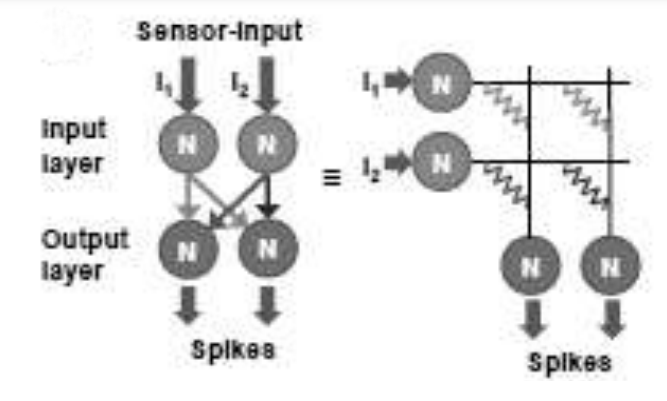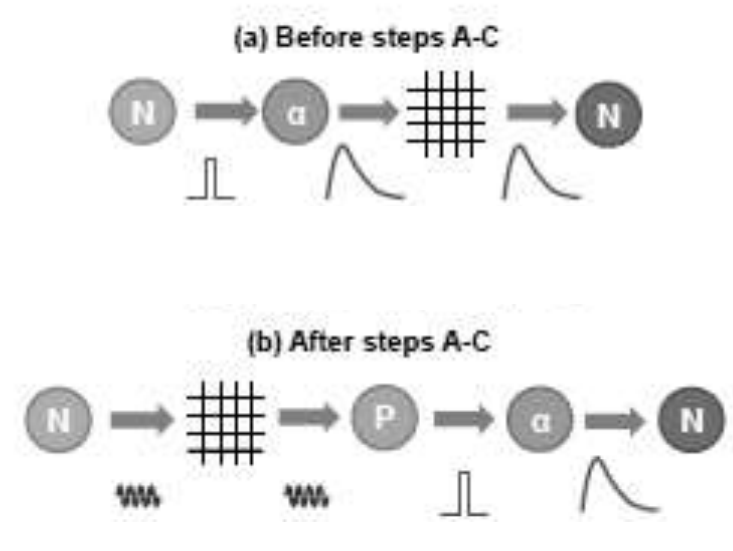The invention addresses the challenge of simultaneous read and write operations in Spiking Neural Networks (SNN) that utilize a cross-bar architecture. This architecture typically requires small amplitude biases for reading and large amplitude biases for writing, which complicates concurrent operations. The invention proposes a solution involving a Frequency Division Multiplexer (FDM) and a filter to manage and separate read and write pulses, enabling efficient simultaneous operations.
Figure (1) The SNN showing a typical neural network translated to hardware with pre-synaptic neurons-based input driving a Resistive Random-Access memory (RRAM) cross-bar based synaptic array further driving post-synaptic neurons-based output; (2a) Illustrates a square pulse used as a spike driving the synaptic RRAM array, (2b) Illustrates an alternative of Fig. 2(a) showing a burst of time-varying input voltage driving the RRAM cross-bar based synaptic array
In traditional SNNs, concurrent read and write operations are difficult because they require different bias amplitudes. Existing solutions like Time Division Multiplexing (TDM) require clocks, which consume power and are not biologically realistic.
- RRAM Cross-Bar Based Synaptic Array: Utilizes Resistive Random-Access Memory for efficient synaptic operations
- Frequency Division Multiplexer (FDM): Separates read and write pulses by frequency
- Filter: Removes write pulse components while retaining read pulse components to drive the post-synaptic neuron
- Pulse Components: Read pulses are high-frequency signals, while write pulses are low-frequency and segmented into fast spike and slower time-keeping portions
- Simultaneous Read/Write Operations: Efficiently handles both operations concurrently without interference
- Capacitor Integration: A capacitor in parallel with RRAM to block low-frequency components of the write pulse
- Low Power Consumption: Avoids the need for power-hungry clocks
- Biologically Realistic: Supports asynchronous, clock-less operations similar to biological neural networks
- Improved Accuracy: Minimizes read errors by separating and filtering pulse components effectively
The prototype consists of a hardware network with an RRAM cross-bar synaptic array, integrated FDM circuits, filters, and rectifiers. It demonstrates the ability to perform read and write operations simultaneously by managing high-frequency and low-frequency signals through precise filtering.
The technology is implemented in a GlobalFoundries 45nm technology. The prototype is demonstrated to show area and power efficiency. The system-level demonstration of the neural network using the LIF neuron is ongoing.
3
This technology can lead to significant advancements in AI, making systems more energy-efficient and capable of real-time learning. It can drive innovations in various fields, from healthcare (e.g., brain-computer interfaces) to autonomous systems (e.g., self-driving cars), ultimately contributing to the development of smarter and more efficient technologies.
- Semiconductor Industry: Manufacturing advanced integrated circuits and components for neuromorphic systems
- Artificial Intelligence and Machine Learning: Enhancing SNNs for low-power, brain-like learning and recognition tasks
- Neuromorphic Computing: Developing hardware that mimics the neural structure of the human brain
- Cognitive Computing: Systems that require real-time learning and adaptation
- Robotics: Enhancing autonomous learning and decision-making capabilities
- Signal Processing: Efficient data processing in neuromorphic systems
- Advanced AI Research: Developing new algorithms and hardware for brain-like computation
- Memory Storage Technology: Innovating new methods for efficient data storage and retrieval
Geography of IP
Type of IP
201821015672
532741


